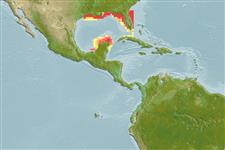>
Clupeiformes (Herrings) >
Alosidae (Shads and Sardines)
Etymology: Brevoortia: From James Carson Brevoort (1818-1887), studie the fauna from Ohio and South Caroline (Ref. 45335).
More on author: Goode.
Environment: milieu / climate zone / depth range / distribution range
Écologie
marin; profondeur 0 - 50 m (Ref. 188). Subtropical; 31°N - 19°N, 95°W - 80°W (Ref. 54290)
Western Central Atlantic: Gulf of Mexico (Florida Bay, Gulf of Campeche, Mexico), but no certain records from Caribbean.
Length at first maturity / Taille / Poids / Âge
Maturity: Lm 18.5, range 15 - 22.5 cm
Max length : 35.0 cm SL mâle / non sexé; (Ref. 7251); common length : 20.0 cm SL mâle / non sexé; (Ref. 188)
Épines dorsales (Total): 0; Épines anales 0. Scutes along belly; upper jaw with median notch. Pelvic fin with rounded hind margin, inner fin rays equal or nearly equal to outer fin rays when fin folded back. Pre-dorsal scales modified; scales in lateral series large, those on back and above anal fin base a little smaller and more irregular than rest. A black spot behind gill opening, followed by a series of spots along flank (Ref. 188). Back bluish gray, Sides brassy green (Ref. 37032).
Occur inshore in summer, but at least some moving into deeper waters from October (Mississippi Delta area). Feed in dense schools, filtering phytoplankton, but probably also feed at the bottom. Apparently breed in winter (October to February, with a peak in January). Salinity tolerance range from 0.1-60 ppt, but the commercial catch is mostly from 5.0-24 ppt. Marketed fresh, salted or canned. Mainly used as source of fish oil; also as fish meal (Ref. 188). Isopod is found in the mouth (Ref. 37032).
Make inshore-offshore movements (Ref. 34923). Larvae stay in offshore waters for 3-5 weeks before moving into estuaries where they grow into adults (Ref. 34923).
Whitehead, P.J.P., 1985. FAO Species Catalogue. Vol. 7. Clupeoid fishes of the world (suborder Clupeoidei). An annotated and illustrated catalogue of the herrings, sardines, pilchards, sprats, shads, anchovies and wolf-herrings. FAO Fish. Synop. 125(7/1):1-303. Rome: FAO. (Ref. 188)
Statut dans la liste rouge de l'IUCN (Ref. 130435)
Menace pour l'homme
Harmless
Utilisations par l'homme
Pêcheries: hautement commercial
Outils
Articles particuliers
Télécharger en XML
Sources Internet
Estimates based on models
Preferred temperature (Ref.
123201): 23.2 - 26.8, mean 24.3 °C (based on 178 cells).
Phylogenetic diversity index (Ref.
82804): PD
50 = 0.5156 [Uniqueness, from 0.5 = low to 2.0 = high].
Bayesian length-weight: a=0.00871 (0.00502 - 0.01510), b=3.11 (2.97 - 3.25), in cm total length, based on LWR estimates for this species & Genus-body shape (Ref.
93245).
Niveau trophique (Ref.
69278): 2.2 ±0.07 se; based on food items.
Generation time: 2.6 (2.2 - 3.0) years. Estimated as median ln(3)/K based on 33
growth studies.
Résilience (Ref.
120179): Milieu, temps minimum de doublement de population : 1,4 à 4,4 années (K=0.15-0.47).
Prior r = 0.62, 95% CL = 0.41 - 0.92, Based on 1 stock assessment.
Fishing Vulnerability (Ref.
59153): Low to moderate vulnerability (31 of 100).
Climate Vulnerability (Ref.
125649): High to very high vulnerability (74 of 100).
Nutrients (Ref.
124155): Calcium = 109 [57, 187] mg/100g; Iron = 1.58 [0.86, 2.78] mg/100g; Protein = 19.1 [17.9, 20.3] %; Omega3 = 0.485 [0.287, 0.818] g/100g; Selenium = 20.8 [11.2, 43.8] μg/100g; VitaminA = 11.3 [3.3, 33.9] μg/100g; Zinc = 1.17 [0.80, 1.68] mg/100g (wet weight);
